A personal website focuses on showcasing your skills, interests, or portfolio with a relaxed, authentic tone, while a company website aims to promote products or services, reflect brand identity, and support business goals professionally. Your choice depends on your purpose, target audience, and long-term plans. If you’re looking to build a clear online presence, understanding these differences helps you decide which approach best fits your needs. Keep exploring to find out more about creating an impactful website.
Key Takeaways
- Personal websites typically focus on individual branding, portfolios, or hobbies, while company websites promote products, services, and brand identity.
- Personal sites usually have smaller budgets, simpler features, and minimal scalability; company sites require larger resources and long-term growth planning.
- Company websites often include advanced functionalities like e-commerce, CRM integration, and support systems, unlike personal websites which are more straightforward.
- Target audiences differ: personal sites aim to connect with friends or niche followers, whereas company sites target customers, clients, or partners.
- Branding and content strategies differ, with personal sites emphasizing authenticity and personality, and company sites focusing on professionalism and brand consistency.
Defining the Core Purpose of Your Website
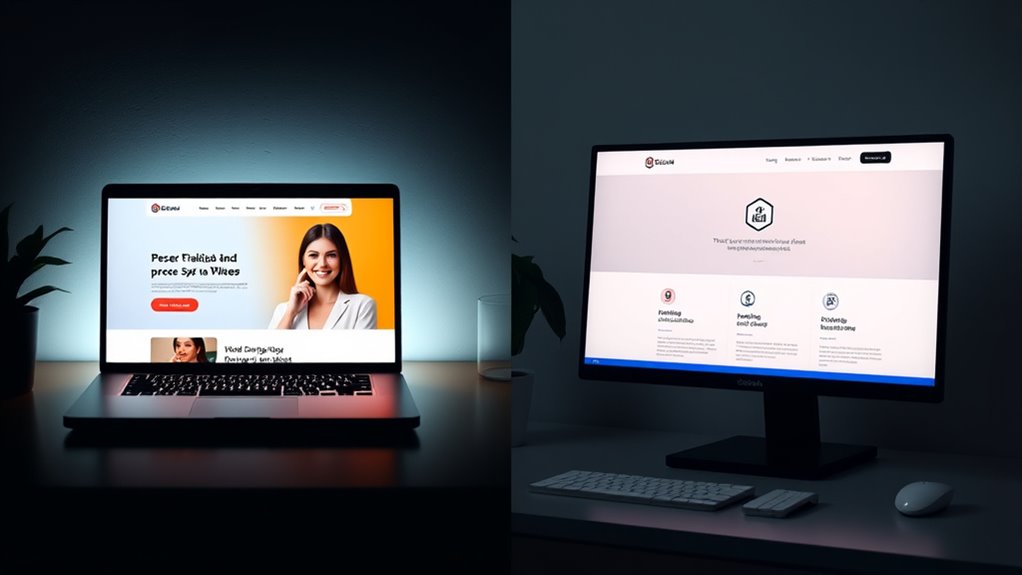
Understanding the core purpose of your website is essential before diving into design or content. Clearly defining this purpose helps you establish branding clarity and keeps your audience focus sharp. Ask yourself what you want visitors to do—whether it’s sharing your work, learning about your services, or connecting with your brand. A personal website might focus on showcasing your skills or portfolio, while a company site aims to promote products or services. By identifying your main goal, you can tailor your messaging and layout to meet your audience’s expectations. This clarity guides every decision, ensuring your website effectively communicates your intent and attracts the right visitors. When your purpose is clear, your branding becomes more consistent and impactful. Understanding content strategy can further enhance your website’s effectiveness by aligning your messaging with audience needs.
Design and Branding Considerations

When designing your website, paying attention to branding and visual elements is essential to making a strong impression. Your visual identity should reflect your personality or company values consistently across every page. Focus on branding consistency by using a cohesive color palette, typography, and imagery that align with your overall message. This helps visitors instantly recognize your website and builds trust. Avoid clashing styles or inconsistent visuals, as they can dilute your brand’s impact. Instead, aim for a clean, professional look that communicates your unique identity. Remember, strong branding not only enhances aesthetics but also reinforces credibility. By thoughtfully integrating your visual identity into your website’s design, you create a memorable experience that resonates with your audience and supports your core purpose. Incorporating visual branding elements can also enhance user engagement and foster a sense of familiarity.
Content Strategy and Presentation
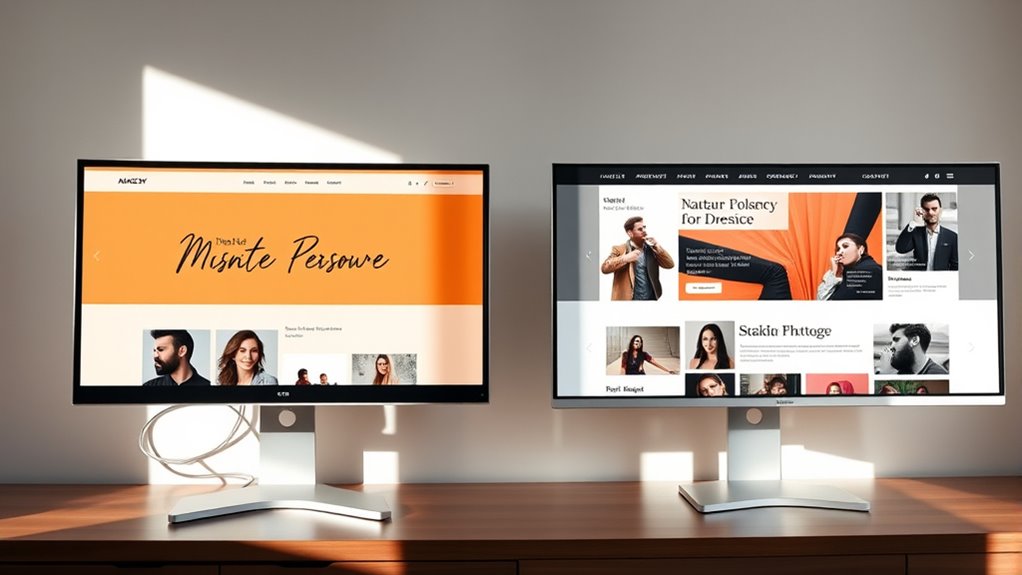
Your content strategy shapes how visitors perceive you or your brand, so consider your tone and messaging carefully. Visual design choices should reinforce your message and keep viewers engaged. Organizing your content effectively helps deliver your key points clearly and keeps your audience interested. Incorporating user engagement techniques can further enhance the effectiveness of your presentation.
Tone and Messaging
The tone and messaging on a personal website often reflect your unique personality and voice, making it essential to communicate authenticity and approachability. Your brand voice should be consistent across all content, establishing trust and recognition. To achieve this, consider these key points:
- Define your core message to guarantee clarity and focus.
- Use a conversational tone that invites connection.
- Maintain messaging consistency to reinforce your identity.
- Balance professionalism with authenticity to stay relatable.
- Incorporate content strategy principles to ensure your message resonates effectively with your audience.
Visual Design Choices
Have you considered how visual design choices shape your website’s content strategy and presentation? Your color schemes set the tone and influence emotional responses, whether you choose vibrant hues for energy or muted tones for professionalism. Typography choices also matter—they impact readability and reflect your personality or brand identity. For a personal website, opting for casual fonts can create approachability, while a company site might favor clean, modern typefaces to convey authority. Consistency in these elements guarantees a cohesive look that guides visitors effortlessly through your content. Effective visual design doesn’t just make your site attractive; it reinforces your message and encourages engagement. Pay close attention to your color schemes and typography choices to craft a compelling, visually aligned platform. Incorporating diverse crochet styles for locs can also inspire creative visual elements that enhance your site’s aesthetic appeal.
Content Organization Strategies
Effective content organization transforms visual design into a seamless experience by guiding visitors through your site logically and intuitively. To achieve this, focus on establishing a clear content hierarchy that prioritizes your most important information. Incorporate multimedia integration strategically to enhance engagement and clarify complex ideas. Here are four key strategies:
- Structure your content with a logical flow, starting with an overview and progressing to details.
- Use headings, subheadings, and bullet points to break up text and improve readability.
- Balance text, images, videos, and interactive elements to create dynamic, engaging pages.
- Guarantee multimedia supports your content hierarchy without overwhelming visitors, maintaining a clean, organized layout. Additionally, understanding local traditions can help tailor your content to resonate more deeply with your audience.
Functionality and Features Needed
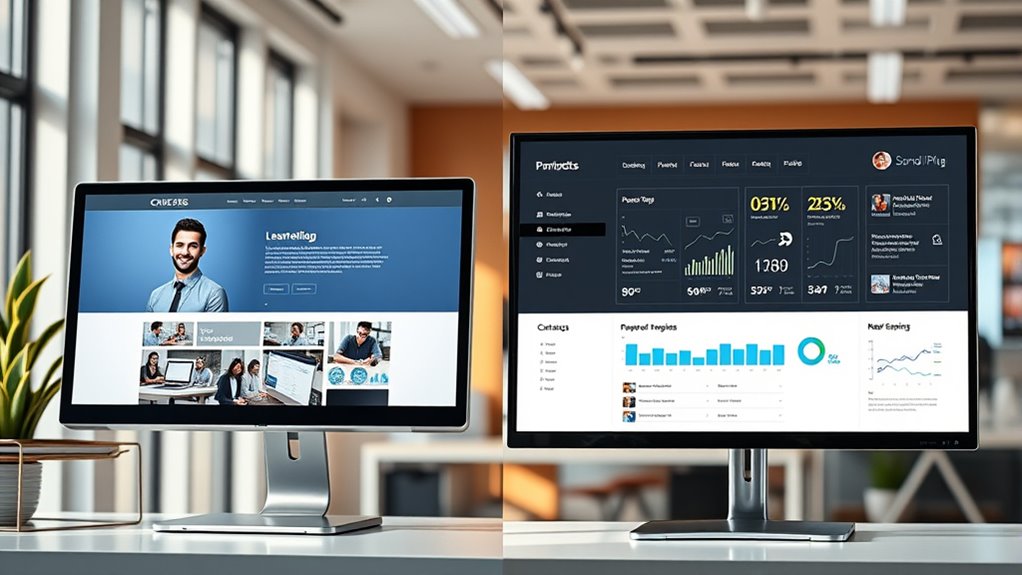
When choosing between a personal website and a company website, understanding the essential functionalities and features is crucial to meeting your goals. You need features like e-commerce integration to sell products or services seamlessly and social media linking to boost engagement and visibility. Consider what tools are necessary to support your goals, whether it’s a contact form, blog, or portfolio. To help visualize, here’s a quick overview:
| Feature | Purpose | Example |
|---|---|---|
| E-commerce integration | Sell products/services online | Shopping cart, payment system |
| Social media linking | Connect audiences, share content | Facebook, LinkedIn buttons |
| Contact forms | Gather inquiries and feedback | Simple contact form |
| Analytics | Track visitor behavior | Google Analytics |
| Mobile responsiveness | Ensure functionality on devices | Responsive design |
| Content management systems | Facilitate easy updates and management | WordPress, Drupal |
Understanding content management systems can significantly streamline maintaining your website’s content and features.
Target Audience and User Experience
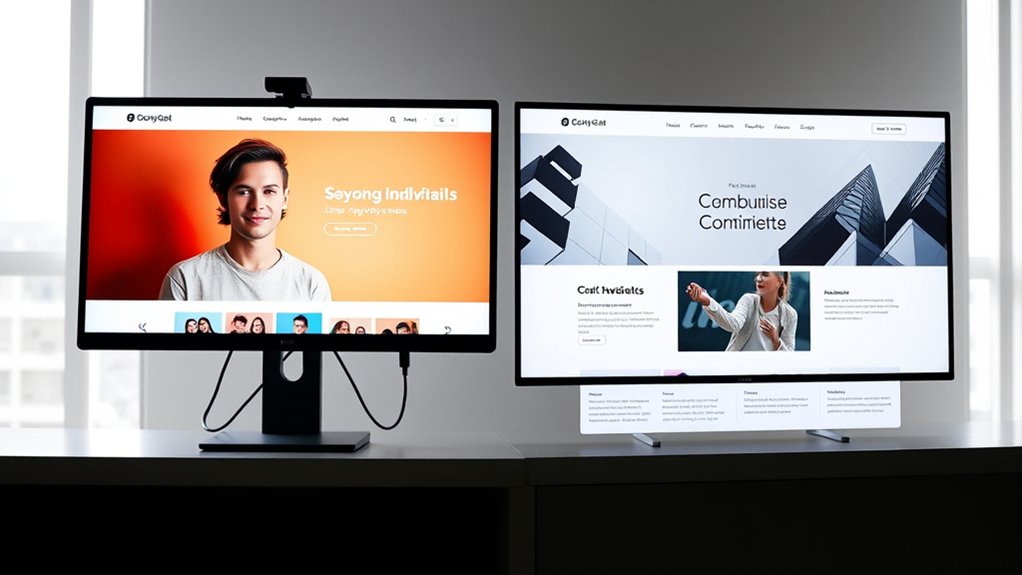
Understanding your target audience is essential for designing a website that meets their needs and expectations. When focusing on audience targeting, consider who your visitors are and what they seek. This helps you tailor the user experience effectively. To maximize user engagement, think about:
Knowing your audience helps create a website that truly meets their needs and keeps them engaged.
- Clear navigation that guides visitors effortlessly.
- Personalized content that resonates with their interests.
- Responsive design for seamless access across devices.
- Fast load times to keep users engaged and reduce bounce rates.
- Incorporating welcoming design elements that create a comfortable and inviting atmosphere for visitors.
SEO and Online Visibility

Optimizing your website for search engines directly impacts how easily your target audience finds you online. Focus on keyword optimization to guarantee your content aligns with what users are searching for, boosting your visibility in search results. Incorporate relevant keywords naturally into your pages, titles, and descriptions to improve rankings. Additionally, backlink strategies play a vital role; earning quality backlinks from reputable sites increases your site’s authority and credibility. Personal websites may rely more on organic growth through targeted keywords, while company sites often benefit from broader backlink networks. Regularly analyzing your SEO performance helps refine your approach and stay ahead of competitors. Ensuring your content is optimized for search engines is essential for maintaining high rankings and visibility. Ultimately, a strong SEO strategy assures your website remains discoverable, driving more traffic and expanding your online presence.
Maintenance and Updates
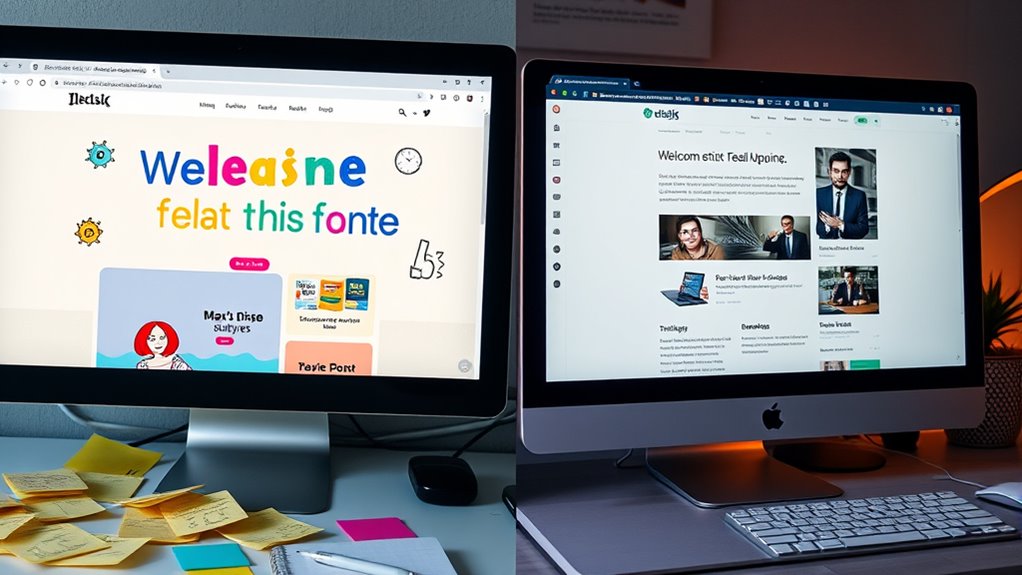
When it comes to maintenance, your choice of content management system impacts how easily you can update your site. You’ll also want to take into account how flexible you need your update schedule to be and whether you have access to technical support when issues arise. These factors determine how smoothly your website stays current and functional over time. Additionally, considering vetted options can help ensure your site remains safe and reliable for visitors.
Content Management Systems
Content management systems (CMS) are essential tools for maintaining and updating websites efficiently. They simplify content management by providing user-friendly interfaces and streamlined workflows. When choosing CMS platforms, consider these key factors:
- Ease of use for content updates
- Compatibility with your website’s design
- Security features to protect your data
- Flexibility for future content expansion
Update Frequency Flexibility
Flexibility in update frequency is essential for maintaining a website that stays current and functions smoothly. When managing your personal or company website, you need the ability to quickly add or modify dynamic content to engage visitors and reflect the latest information. An adaptable platform allows you to adjust your update frequency based on your needs, whether that’s frequent updates for a news site or occasional tweaks for a portfolio. This flexibility helps guarantee your site remains relevant and reliable. If you’re limited in how often you can update, your website risks becoming outdated or stagnant, which can harm your credibility. Choosing a platform that supports easy, timely updates is imperative for maintaining the freshness and accuracy of your content.
Technical Support Availability
Having reliable technical support is essential for keeping your website running smoothly and securely. When choosing between a personal or company website, consider how accessible customer support and technical assistance are when issues arise.
- Determine if support is available 24/7 to address urgent problems promptly.
- Check if multiple channels, like chat, email, or phone, are offered for quick communication.
- Assess the responsiveness of technical assistance, ensuring timely resolutions.
- Verify whether ongoing maintenance and updates are part of the support package to prevent security risks.
A company website often provides dedicated technical support, ensuring continuous assistance, while personal sites may rely on community forums or limited help. Prioritize support options that align with your needs for seamless website operation.
Cost and Resource Investment

When deciding between a personal website and a company website, understanding the costs involved is essential. A personal website often requires a smaller budget, focusing on minimal branding consistency and basic hosting. You can allocate resources efficiently, especially if you handle design and content yourself. In contrast, a company website demands a larger investment, including professional design, branding strategies, and ongoing maintenance, which can strain your resource allocation. While initial costs for a personal site are lower, it might lack the polish and scalability of a company site. Conversely, a company website’s higher investment can pay off with enhanced credibility and functionality. Carefully assess your budget and long-term needs to determine which option aligns best with your resource commitments.
Long-term Goals and Scalability

Long-term goals and scalability play a crucial role in choosing between a personal and a company website. If you’re aiming for long-term growth, consider how each option addresses scalability challenges. Personal websites often lack infrastructure for rapid expansion, while company websites are built to scale efficiently. To make an informed decision, evaluate:
For long-term growth, choose a company website that scales efficiently and supports future expansion.
- Future traffic and data volume needs
- Ease of updating and expanding features
- Infrastructure support for increased user demand
- Potential costs associated with scaling over time
A company website typically offers better support for long-term growth, handling increased scalability challenges more effectively. Personal sites may suffice initially but can become limiting as your goals evolve. Aligning your website choice with your vision ensures sustainable growth.
Frequently Asked Questions
How Do Legal Requirements Differ for Personal Versus Company Websites?
You need to understand that legal requirements focus on protecting user privacy and intellectual property. For personal websites, you must guarantee transparency about data collection, comply with privacy laws like GDPR, and respect copyright. Company websites often have stricter rules, including detailed privacy policies, data security measures, and clear licensing for content. Both must prevent misuse of user data and respect intellectual property rights, but company sites usually face more extensive legal obligations.
What Privacy Standards Should Be Considered for Each Website Type?
When considering privacy standards, you should prioritize protecting user privacy and ensuring data encryption. For any website, implement secure protocols like HTTPS, limit data collection, and be transparent about data usage. You need to tailor these measures based on the website’s purpose and audience, whether personal or business. Regularly update security practices and comply with relevant regulations to build trust and safeguard user information effectively.
How Does Website Ownership Transfer Vary Between Personal and Business Sites?
They say “ownership is nine-tenths of the law,” and it’s true when it comes to website transfers. For personal and business sites, the process of domain transfer hinges on clear ownership rights. You’ll need to update registrars, transfer domain credentials, and confirm legal rights are documented. While personal sites typically have straightforward transfers, business sites often involve more complex agreements, making proper documentation essential to avoid disputes.
What Are the Cybersecurity Risks Specific to Personal or Corporate Sites?
You face cybersecurity risks like phishing attacks and malware infections that target your site. These threats can compromise your data, steal sensitive information, or cause downtime. Personal sites might be more vulnerable due to weaker security measures, while corporate sites often face targeted attacks aimed at disrupting business operations. Staying vigilant, updating your software, and using robust security tools help protect against these specific risks.
How Do Monetization Strategies Differ Between Personal and Company Websites?
You monetize websites through diverse strategies like affiliate marketing and subscription models, but your approach varies based on your goals. With a personal site, you often rely on affiliate marketing to share products you love, earning commissions and building a community. For a company website, subscription models generate recurring revenue and foster loyalty. Both strategies focus on engagement and value, but the scale and purpose differ, shaping your monetization approach accordingly.
Conclusion
Choosing between a personal and company website depends on your goals. Remember, “A journey of a thousand miles begins with a single step.” Whether you focus on building your personal brand or showcasing your business, start with clarity and purpose. Invest wisely in design, content, and updates. With patience and strategic effort, you’ll create a platform that grows with you—because the key to success is consistency and vision.









